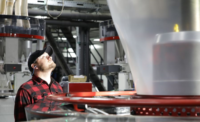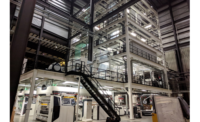senior VP of sales & marketing
US director of sales & marketing
founder and CEO
Next Generation Films
Q: Are you seeing any new trends in blown film lately?
Beuning: The new trends in blown film continue to be around the consumers’ desire for convenience. This can be seen in microwaveable, freezer-to-table, and portability for foods/beverages consumed on the go. Much of this continues to be replacement of traditional rigid packaging – primarily glass and cans. As a film supplier, we need to have films available for these newer flexible packaging applications. Additionally, there is the continuing move to lightweight, or right-weight, existing flexible packages and finally green initiatives continue to gain momentum.
Crimmin: Trends these days aren’t really new, just different variations of what we’ve been doing. Thinner, stronger and stiffer are all still the mantra. In the case of films used in laminations, the trend is definitely thinner, while trying to maintain the same properties. Coextruded films really come into play with the abilities of using different resins in each of the layers providing multiple properties.
Frecka: There is an increased market demand for barrier films, with an emphasis on low OTR and WVTR rates and more. However, 7-layer and 9-layer lines combine the best use of nylon, EVOH and tie layer materials. The advent of micro-layers has added more flexibility in using less expensive raw materials in a substrate. Tighter layer tolerances result in added quality overall, at less cost. Subsequently, these new benefits, combined with new polymers, provide the marketplace with exciting new cost effective 7- and 9-layer films.
Q: What are your customers requesting more of? Less of?
Crimmin: This really depends upon what market your customer is in. For example, companies who are in the food packaging market are asking their suppliers to get more stringent food safety certifications. Over the last several years, there have been several recalls of food products and everyone wants to avoid that situation. The result has been a higher focus on food safety throughout the manufacturing process.
The first word that comes to mind is sustainability. Customers, both converters and end users, are looking for less packaging at a lower cost. The standup pouch is making major inroads into the rigid packaging market by reducing the amount of packaging necessary. This saves on packaging, logistics and fuel costs.
Beuning: A.) Our customers are requesting better, faster and more innovative. We are challenged daily to work collaboratively with them to provide packaging solutions and problem solving. Service and delivery expectations continue to ratchet up. Starting with the brand owner and working through to the film converter, there is more focus than ever on keeping inventories low – putting pressure on us to meet shorter lead times. Reliable and consistently improving film quality is expected and is more valued, given the multi-color high speed presses in the marketplace today.
B.) No surprise here…Our customers want less cost. Certainly the cost of the film we provide is a component in their finished package costs, but they realize that the right film supplier can help them run their operations more efficiently with less downtime, less waste and lower scrap rates.
Q: What would you like blown film machinery manufacturers to know (specifically machinery your company has on-site)? How can machinery be improved upon? What do you like about the machines?
Crimmin: There have been some tremendous improvements made in blown film lines. With increased automation, adjustments which previously required several hours using manual controls now require only a few minutes. Automation also provides the ability to produce films with tighter tolerances.
With every advance in technology come the growing pains. The automation improvements are computer-based, and like many of the technology advancements, people no sooner master one then a new upgrade is available with a new learning curve. Making these upgrades more user-friendly would assist in shortening the learning curve significantly.
Frecka: Regarding blown film equipment, the Germans ship more lines than anybody to the states. All domestic suppliers fall short in being able to deliver updated technology and advancements. The 7- and 9-layer dies require a year’s worth of fabrication, which makes it very tough to react to new market opportunities. Next has added 40 mm pounds of new 5-/7-/9-layer capacity in the past two years.
Beuning: Manufacturers continue to make great strides in increasing rates while maintaining excellent gauge control. Continued focus on die design and reduced purging times with flexibility to process a wide range of polymers is very important going forward. Ease of operation and continued improvement in reliability has played a key role in improving our productivity.
Q: What would you like raw materials vendors to know? What do you like or not like about dealing with them?
Beuning: Resin producers have a strong desire for regular, known and forecastable demand. As a film producer, we find many of our customers’ demands to be unpredictable. This disconnect can make pricing and even supply, harder to control when we see order variability from our customers. Compounding the situation is that the resin suppliers continue to push days of inventory down to minimal levels, oftentimes using exports to manage this. Any outages anywhere within the supply chain creates immediate problems – again, usually in the price or availability of supply.
Crimmin: 1. With the push into railcar production, it is getting much more difficult to get boxed or bagged product for trials in a timely manner. This causes missed opportunities for those vendors that do not manage this properly.
2. Generic customer service email boxes that our suppliers frequently utilize create a situation where we do not know who is managing our orders and delivery confirmations. This causes confusion and wastes their customer’s time obtaining a response. With additional capacity coming on line over the next 3-4 years, RKW Danafilms is looking for suppliers willing to start exporting product to our European and Asia locations ahead of this. We understand that the margins may not be as large as selling in North and South America for the short term, but the approvals and supply chain will be well established in order to have a global supply relationship. This will give a better opportunity in the long run for those suppliers willing to partner with RKW Danafilms in the global market.
Q: What is your number one headache in production, and/or the number one headache for the company overall?
Crimmin: The biggest headache for production is the amount of changeovers and the scrap incurred when we make short- to mid-sized production runs. Scheduling and production becomes a balancing act.
Grouping similar films together with similar sizes and then meeting customer ship dates, as well as minimizing scrap, is truly the work of a very coordinated team.
Beuning: First off, at Charter NEX we don’t have headaches – we have “opportunities.” Our number one opportunity in production is visual defects in the film caused by either a machine issue or a polymer problem. Always difficult to troubleshoot and with multi-layer dies, the complexity of disassembly and cleaning has continued to be more expensive and time consuming.
Q: What kind of advice would you like to give to your customers or potential customers?
Beuning: Simply, “all film is not created equal.” You need a film supplier that can consistently produce high quality film. One that has the right equipment that is well maintained, one that has training programs in place to assure that things are being done consistently correctly, one that has a commitment to continue to improve. A lower-priced film can quickly become a liability if it causes a disruption in your manufacturing process and causes you to miss an important delivery date to your customer.
Frecka: Next Generation is the fastest growing specialty co-ex film company in America today. Our polymer science understanding, coupled with 20 years of blown film processing techniques, deliver unique film substrates worldwide, with over 200 million pounds of capacity. While Next is continually expanding, we have not lost our mission statement: Customer is King. Our focus remains to be the best specialty film manufacturer on the planet.
Exclusive Online Content
Q: What is your company’s bread and butter?
Beuning: Our bread and butter is polyethylene sealant films used in food and beverage packaging. We make everything from simple mono layer films to complex 9-layer barrier films. We are a film solutions company and have a wide variety of products to meet demanding flexible packaging challenges.
Crimmin: RKW Danafilms main market is the sealant webs for laminations. We produce a variety of films which meet the different requirements for a product being packaged and the equipment doing the packaging. Those requirements range from specific sealing conditions, seal strength needed and the type of package being sealed. Monolayer and coextruded films (up to 7 layers) are produced at two plants and sold both domestically and internationally.
Coextruded films containing barrier layers are used for primarily food and chemical packaging. By utilizing EVOH and/or Nylon films can provide barrier properties to oxygen and/or chemical resistance.
Frecka: Two years ago, NEXT's "bread and butter" would have been strictly 3-layer films for a wide variety of applications. However, by the end of 2014, NEXT will house a pair of 5-layer and 7-layer lines with an additional 9-layer line as well.
Q: What is your company’s most ubiquitous film?
Beuning: Three-layer coex films continue to be our most popular product sold in the marketplace today. Our coex films are used in many different applications and in many different markets. Because the nature of our business is specially formulated films, much of what we do with the specific resin blending and layers is customized for the specific application.
Crimmin: RKW Danafilms most ubiquitous films fall into two categories: monolayer & coextruded. Monolayer blends of Octene and other LDPE type films have become the workhorses of the lamination industry. The combination of superior strength and excellent hot tack make these films suitable for most laminations.
The RKW Danafilms EVOSeal group of barrier films is the workhorse of our coextruded films. The combination of sufficient barrier properties combined with excellent sealablity makes these films excellent choices for a wide range of food packaging applications.
Frecka: Next Generation Films was founded on sustainability (source reduction) principles; thus, we are able to bring higher substrate performance deliverables at reduced thickness in most film applications. Our new Research and Development Laboratory measures and identifies all molecules found in plastic substrates today, including complicated 9-layer co-ex structures. NEXT is very active in molecular architecture of performance based plastic pellets. Film buyers need to understand that film technology is advancing rapidly and cost based objectives can be met with greater price/performance relationships than ever. NEXT is evolving very rapidly to meet the new market demands of our industry.
Q: Any other thoughts?
Frecka: Regarding the anticipated impact on lower resin prices due to shale gas, we do not foresee prices dropping in the year 2014 as supply and demand is balanced well and export activities are robust.




